5 AI workflows that save our community managers hours each week
Running a community is one of the most rewarding things you can do as an entrepreneur. But let’s be honest—not all the work you do is equally meaningful.
For every energizing conversation or connection you spark, there are dozens of repetitive, low-impact tasks: flagging spam, renaming vague posts, or making sure no question slips through the cracks. These are necessary to keep your community healthy, but they’re also draining—and not where your unique value as a community manager lies.
What if you could automate the least meaningful parts of the job so you could focus your time and energy on what matters most: creating impact, strengthening relationships, and building the kind of community people want to return to every day?
At Circle, we wrestle with this reality every day. Our customer community has over 10,000 active members each month, with hundreds of new posts, comments, and discussions happening daily. But here’s the catch: we don’t have dozens of people running it behind the scenes.
In fact, we have just three.
That reality pushed us to ask: How do we keep this highly-engaged community running smoothly without burning out our small team?
This year, AI gave us new tools to answer that question. We saw an opportunity to rethink how we work, starting with one of the most essential yet time-consuming parts of community management: moderation.
First with AI Agents, and now with AI Workflows, we’ve been able to start automating moderation in ways that have taken the pressure off our team while making sure members consistently experience a space, thriving, and supportive space.
The examples you’ll see in this article are real workflows we’ve recently set up in our own community. They’re fresh, they’re real, and they’re what we’re most excited about right now when it comes to the future of community management… just a bit more automated.
The best part? They’re already making a massive difference.
Before there were AI workflows, there was…
Circle’s Workflows are our native automation tool, already used by thousands of community builders to streamline everything from onboarding new members to nudging engagement, managing operations, and handling routine admin.
Think of them as a simple formula:
Trigger → Filter → Action
What’s new is that we’ve now enhanced this with AI capabilities. That means your automations are no longer bound by rigid rules like “if a member posts in X space , then do Y.” Instead, they can understand nuance, context, and intent.
That means your workflows don’t just execute rules according to pre-set triggers: they can interpret what’s happening in your community.
This is brand new territory—for us, for our customers, and for community builders everywhere. But it’s also a glimpse into the future: where community management teams treat AI not as a gimmick, but as a real teammate helping them scale.
What are AI workflows, really?
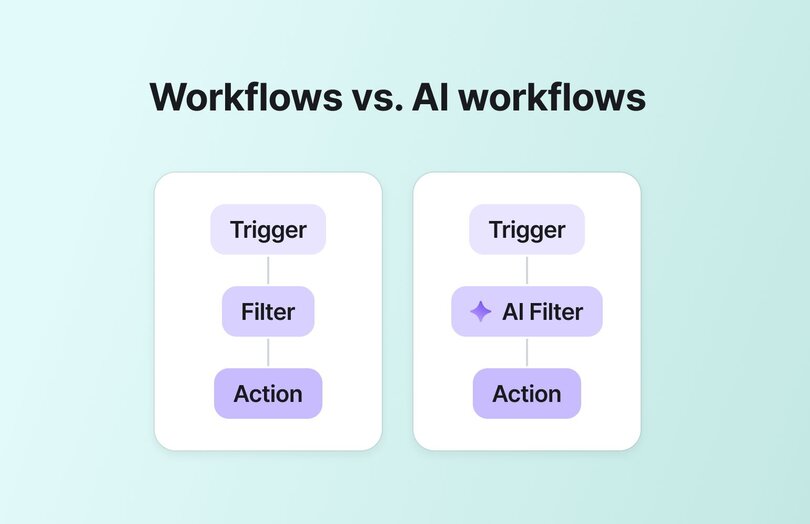
AI Workflows take the classic workflow formula from above and add a layer of intelligence in the filter.
With an AI filter in the middle, workflows don’t just look for keywords or rigid rules. They can actually understand context. That means they can:
- Tell the difference between “Buy my product now” (spam) vs. “Where do I buy this?” (a genuine question).
- Detect tone—like frustration, confusion, or gratitude—so you can automatically catch member activity most important to you
- Go deeper into the meaning of a post, surfacing what a member is really asking.
- Learn and adapt over time as you refine them.
So why does this matter? Because communities thrive on human connection, not human busywork.
AI Workflows take the repetitive, low-value tasks off your plate, so the work that’s left is the meaningful part—the part only you can do. In other words, they don’t just save time. They protect the quality of your community and the energy of the people running it.
Breaking down the building blocks: triggers, filters, and actions
Circle’s AI Workflows are powered by an ever-growing library of triggers and actions.
| Triggers: the "when" | AI Filters: the "if" | Actions: the "what" |
|---|---|---|
A member publishes a post. A member leaves a comment. A post has no replies after 24 hours. A new member joins a space. A milestone (anniversary, X posts) is reached. | Is this spam or self-promo? Is this post vague, confusing, or a duplicate? Is this post rich in detail? Is the member frustrated or asking for clarification? Has this question gone unanswered? | Hide or flag a post. Rename a post title. Report a comment. Close a resolved thread. Comment automatically with resources. Send a DM or email to the member. Move a post, assign a topic. |
Why AI workflows matter
The elephant in this room (and most others) is that many community entrepreneurs are skeptical about AI.
The fear? That it’ll make things feel robotic—or worse, replace the authentic connections that make communities work.
But the truth is, AI isn’t here to replace you. It’s here to scale you. And if used right, and well, it’ll give you more space to do what you love.
As Pedro, one of our community managers, puts it:
“AI handles the busywork of moderation—so you can lead your community without burning out.”
AI-powered moderation: how we do it at Circle
When you’re running a community at the scale of Circle’s (10k active members every month), moderation can’t just be reactive. It has to be intentional. But what do we mean by that?
For us, moderation isn’t just about catching spam or removing the occasional off-topic post. It’s the ongoing work of keeping the community safe, healthy, and on-topic, while also making sure the most valuable conversations rise to the surface.
That means enforcing our Code of Conduct and Community Guidelines, proactively flagging or removing posts that don’t belong to the community, curating spaces so members can find what matters most, and gently nudging members so their posts better align with the community’s purpose.
That’s why all the community managers worked closely with our product team, who built AI Workflows with the moderation use case in mind. Circle’s own community became the testing ground.
Here’s how we’ve started putting AI automations to work to solve for our most time-consuming moderation tasks. Each example follows a simple formula:
Problem → Setup → Result
🛑 1. Enforcing our community guidelines
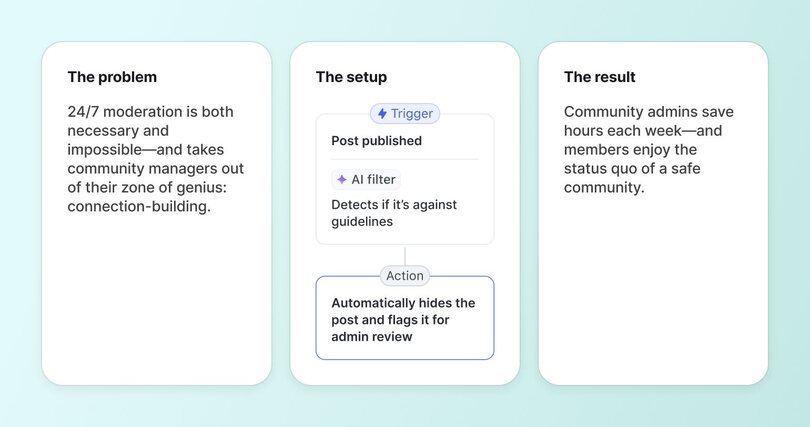
The problem
Community guidelines are like trail markers in a national park: they show members how to engage—and how not to engage—so everyone can feel safe, supported, and respected. But as communities grow, upholding those guidelines gets harder. Spam, self-promo, and off-topic posts sneak in, and moderating manually quickly becomes a full-time job.
The setup
My team built an AI Workflow triggered whenever a member publishes a post, which uses an AI filter to scan the content of the post and decide whether it fits the community guidelines.
- Trigger: Post published.
- AI Filter: Detects if it’s against guidelines (i.e: promotional, bug/technical issue better suited for support channels etc.)
- Action: Automatically hides the post and flags it for admin review.
The result
Moderation and follow-up DMs used to take our community managers 1-2 hours per day, and now saves each of them 30–60 hours/month. 🤯
- Hours saved each week on manual moderation
- Anything harmful, off-topic, or against guidelines is filtered out before it reaches members
- Admins can focus on starting conversations and building connection, not repetitive moderation tasks
✏️ 2. Renaming post titles to make them easier to find and answer
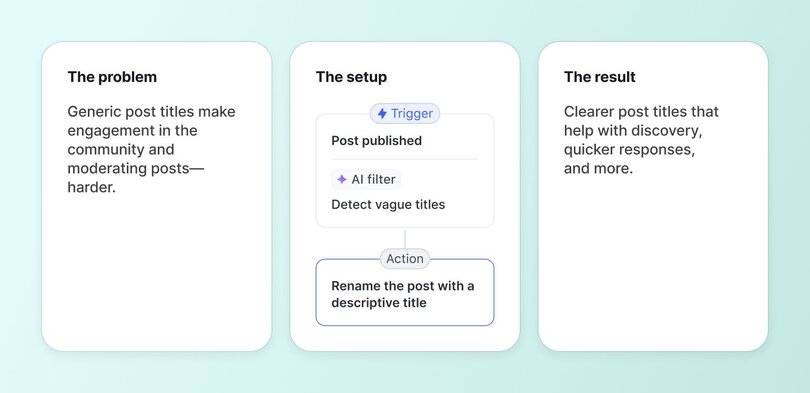
The problem
Posts titled “Help!” or “Question” aren’t helpful. They clutter the feed, make search harder, and bury more valuable conversations.
The setup
A simple AI workflow that renames posts that are too short or non-descriptive.
- Trigger: Post published.
- AI Filter: Detect vague titles.
- Action: Rename the post with a descriptive title.
The result
When we analyzed the results of this particular AI workflow, we found that renaming 313 posts saved around ~5h of community management time per month.
- Posts are made clearer without adding to the moderation workload
- Feeds remain high-signal and searchable
- Members get their questions answered faster
Here’s an example of this clarifying workflow in action:
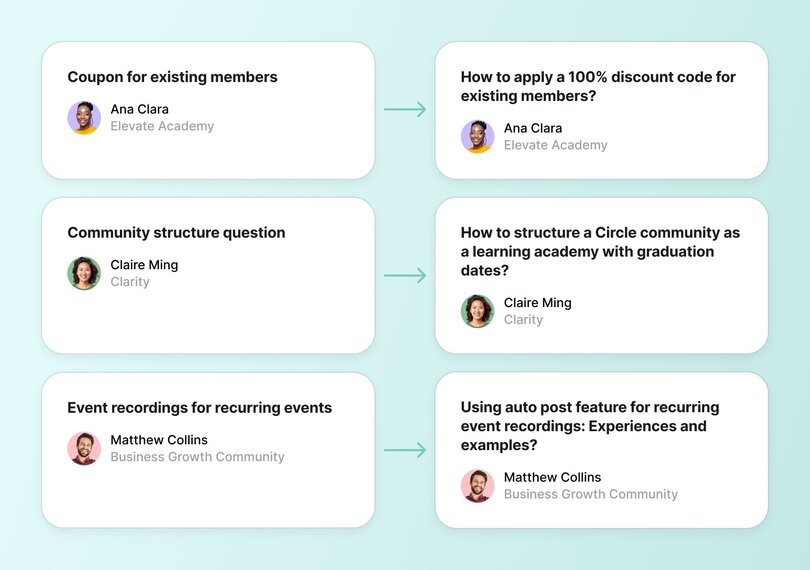
🧹 3. Hiding answered questions from the feed to keep it high-value
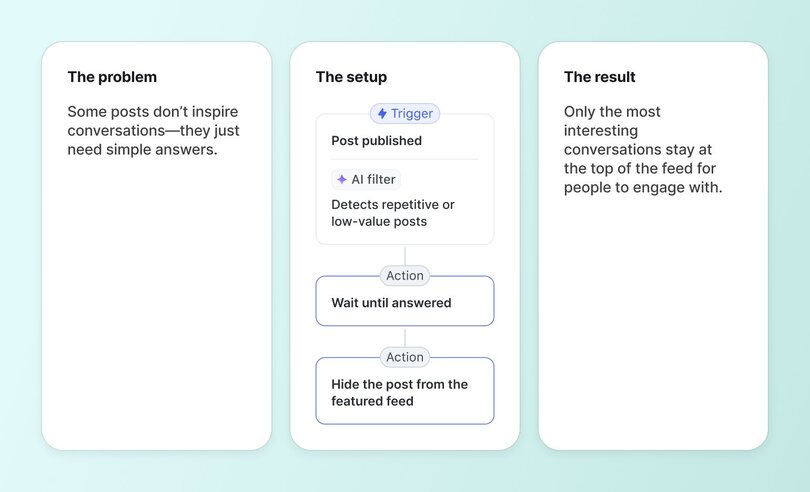
The problem
While all member questions are valid and important, there’s loads of basic questions that have been asked and answered many times. Think “how do I…”, or “will there be a recording” questions that add little ongoing value to others. Plus, over time, they crowd the feed and distract from more engaging content.
The setup
A workflow that automatically detects and hides the most “basic” posts from the community feed.
- Trigger: Post published in “Ask the Community” space
- AI Filter: Detects repetitive or low-value posts.
- Delay: Wait 4 hours for the post to be answered.
- Action: Hide the post from the featured feed.
The result
- Repetitive questions are filtered out once answered
- Members see a cleaner, high-value feed
- Engagement on most strategic posts increase
Here's an example of some basic vs. high-engagement posts:
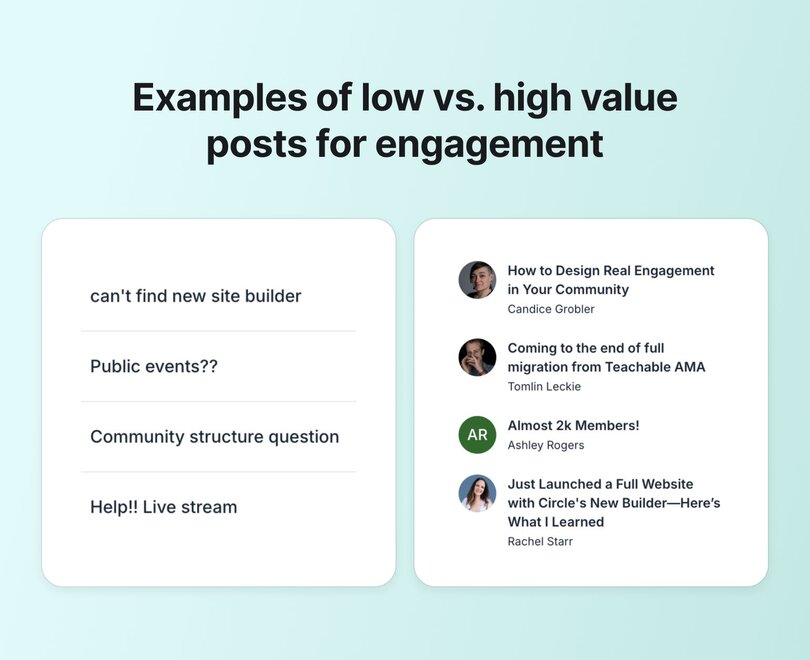
🕒 4. Never leave a question unanswered
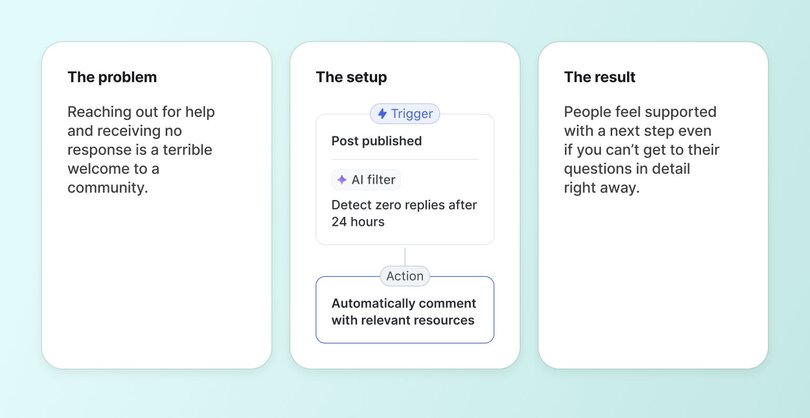
The problem
In the Circle community, the vast majority of questions—over 60%—get answered right away by other members. But with hundreds of posts each week, it’s natural that a few slip through the cracks.
The setup
A workflow that checks if a post in Q&A spaces has gone unanswered for 24 hours and chimes in with a helpful comment.
- Trigger: Post published.
- AI Filter: Detect zero replies after 24 hours.
- Action: Automatically comment with relevant resources.
The result
Deflecting commonly asked questions reduced monthly questions in our community by 22%, which saved our community managers anywhere from 8-16 hours per month.
- No member question slips through the cracks
- Trust grows: members know they’ll always get support
- The community earns a reputation as responsive and reliable
🔍 5. Clarifying ambiguous feature requests
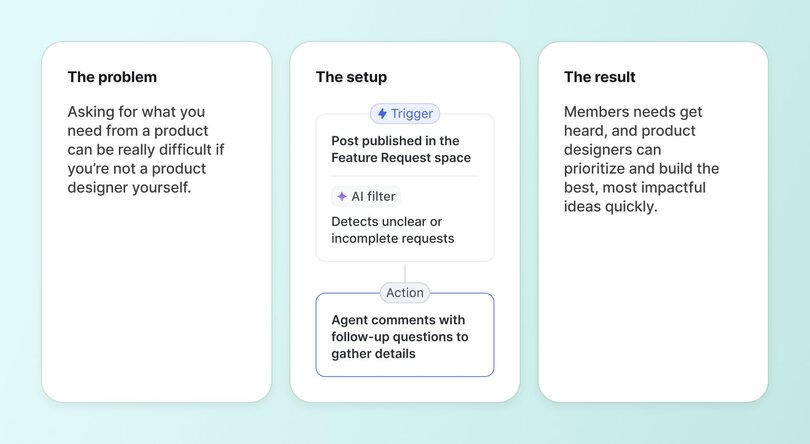
The problem
In our Feature Requests space, members often share great ideas, but sometimes their posts are too vague for the product team to act on. Without enough detail, requests risk being misunderstood or overlooked. Our community managers find themselves asking the same clarifying questions over and over again.
The setup
An AI workflow that detects when a feature request is ambiguous or unclear and asks follow-up questions.
- Trigger: Post published in the Feature Request space.
- AI Filter: Detects unclear or incomplete requests.
- Action: Agent comments with follow-up questions to gather details.
The result
- Requests come in with the context the product team needs to evaluate them.
- Members get an instant response from the AI Agent—no waiting for a community manager—and can easily add details or use cases.
- The team saves time gathering context and can act faster on high-impact requests.
Quickfire workflow ideas you can set up in minutes
But what if your community is small and you don’t need heavy-duty moderation yet? AI workflows are just as powerful for onboarding members, driving engagement, and celebrating milestones. Here are a few examples you can set up in minutes.
1. Welcome new members
- Trigger = New member joins.
- AI Filter = Detects intro language.
- Action = Auto-comment a friendly welcome and suggest 1-2 starter resources to explore.
2. Celebrate high-effort contributions
- Trigger = Post published.
- AI Filter = Detects posts with >300 words, detailed breakdowns, or unique perspectives.
- Action = Send DM to thank the member for their contribution and encourage them to keep going.
3. Detect posts that indicate upsell readiness
- Trigger = Post published.
- AI Filter = Detects posts mentioning how to upgrade, premium features etc.
- Action = Send DM to encourage upgrade.
How to build your first AI workflow step-by-step
Getting started with Circle’s AI workflows is simple.
Step 1: Define your goal
You can’t automate what you haven’t defined. Write a short statement of what you’re trying to solve.
- “I want to reduce the number of hours my team spends manually removing posts that break the Code of Conduct.”
- “I want to make sure every member's question gets an answer within 24 hours.”
Step 2: Choose your “trigger, filter, and action” combo
Think of this as your workflow formula: Trigger → AI Filter → Action.
- Trigger: What event kicks it off? (e.g., member publishes a post)
- AI Filter: What should the AI check for? (e.g., spam, vague title, unanswered post)
- Action: What happens next? (e.g., hide, rename, comment, send a DM)
Step 3: Test, deploy, monitor, iterate
In our own Circle community, we started by testing our first automation workflow in a private space. This let us observe how it behaved, catch any rough edges, and tweak the AI’s responses before turning it on for the full community.
After launch, don’t just let your workflow run on autopilot. Check the results, see where it misses the mark, and make small tweaks. Over time, these adjustments compound, turning a simple workflow into a powerful, reliable part of your community operations.
💡Pro tip: Start small. Don’t try to automate everything at once.
Starting with just one workflow can save you hours in the long run (isn’t that why we’re all here) and help you build confidence before scaling.
So, choose one high-friction task that takes time but doesn’t require deep human judgment.
AI workflows as a free community teammate (worth thousands per month)
AI Workflows, Actions, and Triggers don’t replace the human side of community—they protect it. By automating repetitive tasks, you reclaim the time and energy to focus on the connections that matter most.
All while your little AI teammate chugs along in the background, making your community safer, cleaner, and more engaging by removing fluff, clarifying language, following up, and enforcing community guidelines.
In just one month, our AI workflows have:
- Cleaned up the main feeds by renaming 313 post titles → ~5 hours saved.
- Moderated posts for any guideline violations → saved over 1–2 hours every single day = 30–60 hours saved/month.
- Deflected/answered 100+ questions per month → at 5–10 minutes each, that’s another 8–16 hours saved.
Grand total: ~45–65 hours/month freed up (the equivalent of 10–15 hours/week).
Impact: At a $40/hr benchmark for community management work, these AI workflows could save you $1,800–$2,600/month—while also keeping the member experience consistent and responsive.
👉 Ready to free up your time? Build your first AI Workflow in Circle today.
FAQs about AI workflows for community managers
What are AI workflows in community management?
AI Workflows are intelligent, automated sequences following a Trigger → Filter → Action framework—designed for AI automation in community management. Unlike traditional, rigid, keyword-based rules, these workflows use AI-powered filters that understand context, tone, and member intent.
For instance, a standard automation might flag any post containing "buy." In contrast, an AI Workflow can distinguish between spam ("Buy my product now") versus a legitimate query ("Where do I buy this?"), enabling context-aware moderation, intelligent engagement, and support automation that still feels human and nuanced.
For more on setting these up, see the Circle help article on getting started with AI workflows:
How can AI automate community moderation?
AI Workflows can take on moderation tasks by detecting, categorizing, and acting on content automatically. A few powerful use cases include:
Spam & Promotion Control
- Trigger: Member publishes a post
- AI Filter: Detects self-promotion or rule-breaking content
- Action: Hides the post and flags for admin review
Content Quality Control
- Auto-detects vague titles like “Help!”
- Suggests or applies clearer titles
- Filters out repetitive or low-value posts from featured feeds
Proactive Issue Management
- Monitors for negative sentiment or frustrated tone
- Escalates issues before they spread
- Closes resolved threads automatically
This keeps feeds valuable and relevant, while saving community managers hours of manual review each week.
Can AI automate community member onboarding?
Absolutely. With AI workflows, you can craft personalized, automated onboarding experiences that scale gracefully and warmly:
Welcoming New Members
- Trigger: New member joins
- AI Filter: Identifies intro posts or new joiners
- Action: Posts a welcome message with helpful links
Celebrating Milestones
- Trigger: Member hits posting milestones or anniversaries
- Action: Sends congrats via DM or tags them in a celebratory post
Personalized Nudges
- Trigger: Trial member joins or engagement drops
- AI Filter: Reads activity levels
- Action: Sends personalized DMs to encourage participation or upgrades
Onboarding becomes consistent, scalable, and warm — ensuring no member slips through the cracks.
What’s the difference between AI agents and AI workflows?
When comparing AI automation for communities, the two tools play distinct roles:
AI Workflows
- Fully automated, running quietly across your community
- Based on the Trigger → Filter → Action model
- Best for recurring, rule-based tasks like moderation, onboarding, and engagement
- Designed for efficiency and consistency
AI Agents
- Conversational tools that simulate human-like interaction
- Handle multi-step, nuanced member conversations
- Require prompting but can access a central knowledge engine filled with your content—community space posts, course lessons, custom FAQs, and more
- The knowledge engine allows you to curate and control content by space or snippet, ensuring relevancy and accuracy
So, AI Workflows are your reliable autopilot for repetitive tasks; AI Agents are your dynamic assistants geared for rich, interactive member support.